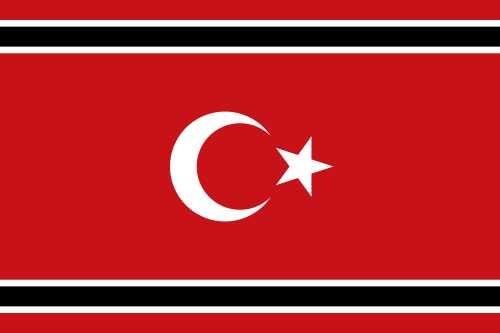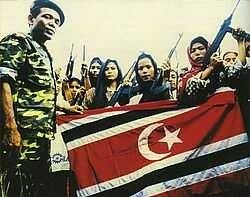GAM (free aceh movement)#aceh
The Free Aceh Movement (Indonesian: Gerakan Aceh Merdeka or simply** GAM, (Acehnese: Geurakan Acèh Meurdèka**), was a separatist group seeking independence for the Aceh region of Sumatra from Indonesia. GAM fought against Indonesian government forces in the Aceh insurgency from 1976 to 2005, during which over 15,000 lives are believed to have been lost.

Since its inception GAM has gone through three stages or three rises and falls. The first was at its birth in 1976 to the year 1979 when it was almost wiped out. The second rise and fall was in 1989 to the early 90s when it received funding and training from foreign countries. The third rise was a result of finally gaining widespread support throughout Aceh as a result of donations and extortion and a large group of potential soldiers who had lost relatives in the previous uprising.
GAM I#
At first the guerilla war of GAM was quite unsuccessful. By 1977 the central government appeared to have entirely neutralised the group.The early GAM efforts were mainly directed at the local Exxon Mobil gas plant. Di Tiro had connections with the petroleum industry and even bid, via a tender process, on a contract to build a gas pipeline which was beaten by the gas giant Bechtel.The reason for this failure was a lack of popular support from both within Aceh and from international sources.*President Suharto *was favoured by countries such as America due to his anti communist policies during the Cold War period.
GAM II#
The group renewed its activities in the 1989, apparently with financial support from Libya and Iran, fielding around 1,000 soldiers.This training from overseas meant that GAM soldiers were much more organised and better trained than the previous insurgency. To counter this new threat Aceh was declared an "area of special military operations" (Daerah Operasi Militer) or DOM in 1989.[citation needed] Special counter- insurgency troops were sent in and Aceh was locked down. Villages that were suspected of harbouring GAM operatives were burnt down and family members of suspected militants were kidnapped and tortured.Amnesty International called the military response "shock therapy" and it is believed 7,000 human rights abuses took place during DOM.GAM forces have also been suspected of Human Rights abuses. Extra judicial executions of suspected military informants and targeting of civilian infrastructure such as schools have both been attributed to GAM operations.
In 1996 the Indonesian government announced the end of GAM.as the counter-insurgency operations had effectively destroyed GAM as a guerilla force. Surviving GAM members were forced to hide in Malaysia.
GAM III#

*Female soldiers of the Free Aceh Movement with GAM commander Abdullah Syafei'i, 1999*
The fall of* Suharto** in 1998 and the decision of his successor President Jusuf Habibie to withdraw troops from Aceh as part of **democratic reform gave space for GAM to re-establish itself, recruiting youths by exploiting brutality stories of Indonesian military. Increasing violence beginning in 1999 by GAM rebels against government officials and Javanese residents, buoyed by massive weapons smuggling from Thailand *by the GAM, led to an increase in military presence. Troop numbers are believed to have risen during the rule of Megawati Sukarnoputri. In 2001–02 the combination of military and police forces in Aceh had grown to about 30,000. In one year this number jumped to 50,000 operating in what the International Crisis group called, "a virtual legal vacuum".The security crackdowns during this time resulted in several thousand civilian deaths.The government launched a large 2003–04 Indonesian offensive in Aceh against the GAM in 2003 with some success.